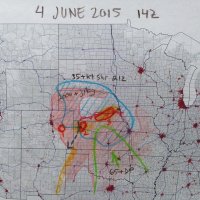Royce Sheibal
EF3
Another day with ENH in Nebraska....another possible bust!
This is one of those rare days where GFS and NAM agree on everything it seems....yet I still feel like today isn't going to produce (at least where it should). I don't think I've had a forecast this year where the NAM and GFS were even close on solutions...so today feels odd.
By 00z some extremely sexy 0-3 SRH moves into SC Neb / NC KS. 600+ on NAM... NAM is showing some major rain cooled air at the time, so cape is low / appears capped (but we still get a 3.5 EHI and a 3-4 STP). Based on what happened yesterday, I'm inclined to believe that the stabilization form this morning will make convection hold off until well after peak heating (probably starting around 5-6pm). There will likely be a window from 5pm till about 9pm for tors, possibly sig, if things can get going. After that things will go MCS yet again, with embedded cells possible.
My Baby, NAM 4k (which did terrible yesterday) is showing an area of extreme 0-1 EHI just west of Lincoln, NE by 00z. But I have a hard time trusting it because it's forecasting ongoing precip all day and it often overplays that in meso-scale situations. Other High Res Models show precip ongoing most of the day further south into KS with Nebraska drying out and capping until 5-7pm, at which point we get 5+ STP and things might get crazy.
Again, gonna be one of those feast/famine days it seems.
My Target: Hebron, NE. (But my wife probably won't let me chase).
This is one of those rare days where GFS and NAM agree on everything it seems....yet I still feel like today isn't going to produce (at least where it should). I don't think I've had a forecast this year where the NAM and GFS were even close on solutions...so today feels odd.
By 00z some extremely sexy 0-3 SRH moves into SC Neb / NC KS. 600+ on NAM... NAM is showing some major rain cooled air at the time, so cape is low / appears capped (but we still get a 3.5 EHI and a 3-4 STP). Based on what happened yesterday, I'm inclined to believe that the stabilization form this morning will make convection hold off until well after peak heating (probably starting around 5-6pm). There will likely be a window from 5pm till about 9pm for tors, possibly sig, if things can get going. After that things will go MCS yet again, with embedded cells possible.
My Baby, NAM 4k (which did terrible yesterday) is showing an area of extreme 0-1 EHI just west of Lincoln, NE by 00z. But I have a hard time trusting it because it's forecasting ongoing precip all day and it often overplays that in meso-scale situations. Other High Res Models show precip ongoing most of the day further south into KS with Nebraska drying out and capping until 5-7pm, at which point we get 5+ STP and things might get crazy.
Again, gonna be one of those feast/famine days it seems.
My Target: Hebron, NE. (But my wife probably won't let me chase).


